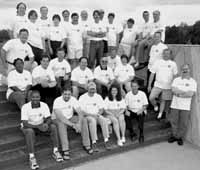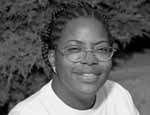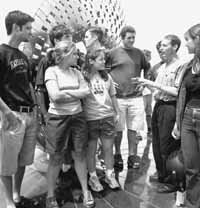 |
|
Weaving the QuarkNet by Kurt Riesselmann
QuarkNet is a network of dedicated particle physicists and high school teachers, providing high school students with first-hand experience in science, involving them in aspects of R&D and providing opportunities to interact with real-life scientists. QuarkNet aims at teaching junior and senior high school students introductory physics concepts and experimental methods by doing "the real thing." To start this network, Keith Baker of Hampton University, Marge Bardeen of Fermilab, Michael Barnett of Lawrence Berkeley National Laboratory and Randy Ruchti of University of Notre Dame recruited particle physicists from around the country to serve as coaches and mentors for local high school teachers. By 1999, they had established the basis for twelve QuarkNet centers. They hired four educators to coordinate the activities, to monitor and nurture the QuarkNet program, and to visit the QuarkNet teachers at their high schools, even sitting in on classroom sessions.
Back to class
"QuarkNet is a very challenging physics program," said Texas teacher Darren Carollo, comparing it to other educational training programs. Carollo works with inner city minority students in Dallas and had just completed a week at Fermilab. "The math is the easy part for me. But the concepts and working with objects that I cannot touch, such as particles, are difficult for me. The talks by Fermilab's theorists have helped a lot in creating a visual picture."
Carollo has experience in software programming and Internet applications. For QuarkNet he will develop software to display data of particle collisions on computer monitors. As they learn new skills, Carollo and his colleagues bring their knowledge to the general physics courses they teach. Each teacher's research project is the stepping stone to provide selected students the pathway to real-life research experience.
Physics Ponzi scheme
First Prize: One week at Fermilab
"Participating in the QuarkNet training session here at Fermilab, I feel like a kid in a toy shop," remarked Ken Taylor from Lake Collins High school in Dallas. Taylor has a Ph.D. in physics, not a pre-requisite for the program. He worked on federal research programs before he decided to become a high school teacher.
"They really get us excited about particle physics," commented Shannon Thorne-Brackett Vergara, who learned about QuarkNet from Ken Cecire of Hampton University. She had her first particle physics contacts through the RECET program at the University of Virginia, sponsored by the National Science Foundation. But she found it was difficult to convert research experience to classroom teaching.
"With the QuarkNet program they allow us to gain basic knowledge about particle physics, provide research experience. Then we are working with the mentors at our local QuarkNet university to actually transfer the information from research projects into the classroom," explains Vergara. "The QuarkNet program has helped me to see my part in the whole research program, and it provides continuous support."
QuarkNet staff members Ken Cecire of Hampton University, Andria Erzberger of Lawrence Berkeley National Laboratory, Tom Jordan of Fermilab and Pat Mooney of Notre Dame organized the weeklong training session. In addition to intensive lessons, which included in-class data-reduction sessions, the teachers visited the detector and accelerator facilities. Lectures by well-known research physicists completed the program.
"The second day of training, I saw the teachers change from teachers to apprentice scientists. The transformation was amazing," Jordan said. "We gave them these data, and they had these meetings to discuss what they had to do with the data. They were arguing with each other, challenging each other andˇthinking together."
Data from particle detectors
"When students need to do a physics problem, they want to relate it to the real world," said Taylor, who is optimistic that he can use his QuarkNet experience in the classroom. "For example, when the curriculum requires the students to calculate a magnetic field, I can now relate this problem to the magnets of the Tevatron accelerator. QuarkNet also gives me useful examples for my computer lab classes."
Concepts like conservation of momentum and energy are an essential part of physics education. QuarkNet gives students the opportunity to learn these concepts while analyzing data taken by physics experiments at the frontier of scienceˇexperiments that teachers helped build.
The QuarkNet program can also help schools in the perennial search for more funding. Taylor's school district, impressed by the QuarkNet program, has already committed several thousand dollars to buying new physics equipment.
Student involvement at its best
"We get spools with 2,500 meters of fibers, and we check, bundle and shield them. Then we send the fibers to Fermilab, where they put connectors on the endings and install the fibers in the detector," DeCelles said. "It is our responsibility to identify fibers that do not work and replace them." The QuarkNet program seems to be well on its way to achieving its goals, stimulating interest in science among high school students. Will they consider studying physics when they start college next year? DeCelles and her peer students didn't hesitate. "Absolutely!" they said. They'd been caught in the QuarkNet. |
| last modified 7/21/2000 email Fermilab |
FRLsDFx9eyfrPXgV
 At first nobody noticed it. It slowly grew, ensnaring physicists at a few U.S. universities. Then, it began to spread beyond the university world. Soon, it may capture teenagers in a high school near you.
At first nobody noticed it. It slowly grew, ensnaring physicists at a few U.S. universities. Then, it began to spread beyond the university world. Soon, it may capture teenagers in a high school near you.
 When complete, a QuarkNet center consists of two lead teachers, 10 associate teachers and at least two particle physicists, who act as mentors and provide access to research projects. The first two QuarkNet teachers of each center, after finishing their eight-week research assignment, recruit associate teachers, who receive a three-week training session the following summer at the local university. By 2005, this physics education "pyramid scheme" will result in 60 QuarkNet centers with a total of 720 teachers, reaching out to 100,000 students annually. Each year, about 5000 students will have the opportunity to be involved in a particle physics research project.
When complete, a QuarkNet center consists of two lead teachers, 10 associate teachers and at least two particle physicists, who act as mentors and provide access to research projects. The first two QuarkNet teachers of each center, after finishing their eight-week research assignment, recruit associate teachers, who receive a three-week training session the following summer at the local university. By 2005, this physics education "pyramid scheme" will result in 60 QuarkNet centers with a total of 720 teachers, reaching out to 100,000 students annually. Each year, about 5000 students will have the opportunity to be involved in a particle physics research project.
 "This summer, every morning at 7:30 a.m., five days a week, students of our QuarkNet group are on shift at a science lab near Notre Dame to prepare optical fibers for use in waveguides as part of Fermilab's DZero detector," Martin said. "In the afternoon we have lectures on related physics aspects and how DZero will use the fibers we assembled. In addition to earning some money, we learn a lot."
"This summer, every morning at 7:30 a.m., five days a week, students of our QuarkNet group are on shift at a science lab near Notre Dame to prepare optical fibers for use in waveguides as part of Fermilab's DZero detector," Martin said. "In the afternoon we have lectures on related physics aspects and how DZero will use the fibers we assembled. In addition to earning some money, we learn a lot."